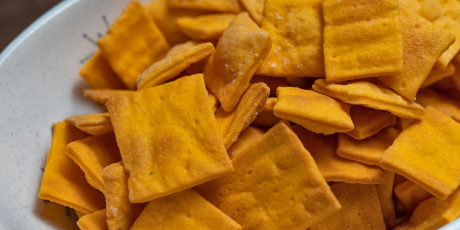
Yield: about 50 crackers
ingredients
To Begin
For Daily Feeding
directions
Special equipment: scale with tare function; quart-sized, wide-mouthed glass jars with lids; a pasta machine; a pizza wheel.Cook’s NoteIf your culture isn't showing signs of life after 3 days, go ahead and start feeding. If, after a few more days, nothing happens, start over and place the culture in a different part of your home. Why the long wait? Even at refrigerator temperatures the starter will continue to do its thing, consuming starches and creating complex (and tasty) chemical waste. Without this time the crackers would lack in both flavor and flakey texture. So…your patience will be rewarded.
Whisk the flour, cheese powder and salt together in a small bowl.
Place 3 tablespoons of the butter and the starter in the work bowl of a stand mixer fitted with the paddle attachment, and work on low speed until creamy and homogeneous, about 1 minute. Stop the mixer and sift the flour mixture over the creamed starter, return the mixer to low and work until a soft dough forms, about 1 minute more.
Turn the dough out onto a lightly floured surface and divide into 4 equal pieces. Press each piece into a 1/4-inch-thick rectangle and wrap in individual pieces of plastic wrap. Refrigerate between 8 and 24 hours (see Cook’s Note).
Place two racks nearest the center of the oven and heat to 350ºF. Line two half-sheet pans with parchment paper.
Retrieve one piece of dough from the refrigerator and dust both the dough and your pasta maker with flour. (Continue to dust the pasta roller and the dough as needed to prevent sticking.) Starting on the widest setting, typically labeled “1,” feed the dough through the roller. Then fold the dough into thirds, as you would a letter, turn 90 degrees and run it through again. Fold the dough into thirds again, turn, and pass it through the roller.
Adjust your pasta maker to the next setting and roll the dough through 3 times without folding. Repeat this step 3 times more on both the 3rd and 4th settings. Transfer the dough to one of the prepared half-sheet pans and repeat the process with the remaining dough, arranging two sheets of dough per pan.
Melt the remaining 1 tablespoon of butter and brush onto the dough. Sprinkle with a generous pinch of kosher salt. Dock the dough thoroughly with a fork and cut into 1-inch squares with a pizza wheel.
Bake for 10 minutes, then turn the pans 180º and rotate from top to bottom. Continue baking until the crackers just begin to brown around the edges, 8 to 10 minutes more.
Remove from the oven and immediately transfer the crackers on the parchment to a rack to cool completely before serving, about 20 minutes.
Lid tightly and store at room temperature.
Mix together 125 grams flour and 125 grams water with a clean hand in a medium glass bowl. Cover the bowl with a tea towel and let sit undisturbed at room temperature until the mixture is full of bubbles and has nearly doubled in size, usually 2 to 3 days. During this time, yeasts and bacteria from the air and from the flour and probably from you will set up housekeeping in the bowl (see Cook’s Note).
Peel back any crust that may have formed and transfer 20% of the culture (50 grams) to a clean, wide-mouthed jar. Stir in 100 grams flour and 100 grams water, loosely screw on the lid and stash at room temperature for 24 hours. (The culture will have a stinky-sour smell at this point.) Discard the rest of the original mixture.
Repeat step 2 every 24 hours for 5 days. By then the culture should smell yeasty-sweet-sour, which means you’re ready to put the starter to work. The cheese crackers are to be made with the discarded percentage of starter.
